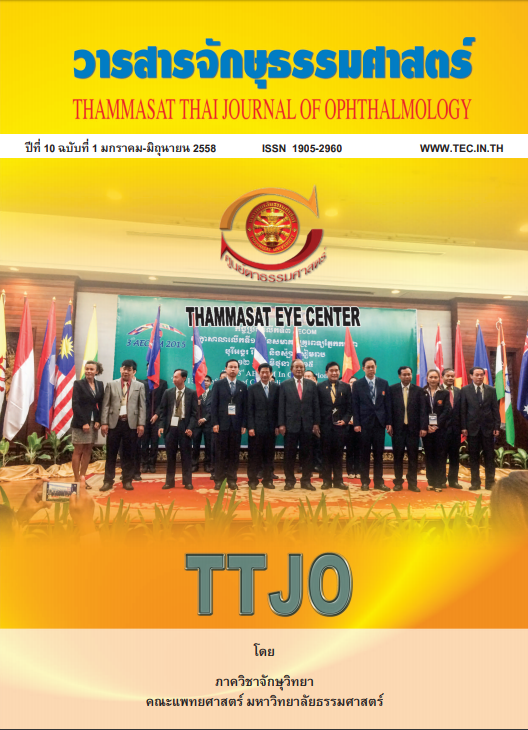ภาวะเนื่้องอกของเส้นเลือดแดงของจอตา
Main Article Content
Abstract
รายงานผู้ป่วยภาวะเนื้องอกของเส้นเลือดแดงของจอตา (retinal capillary hemangioma, RCH) จำนวน 3 รายในแผนกผู้ป่วยนอกจักษุวิทยา รพ.ธรรมศาสตร์เฉลิมพระเกียรติ ผู้ป่วยทั้ง 3 รายที่ได้รับการวินิจฉัยว่า มีภาวะเนื้องอกเส้นเลือดแดงของจอตา มีขนาดก้อนใกล้เคียงกันและตำแหน่งของก้อนมกั พบอยู่บริเวณด้านหน้าของจอตา (peripheral retina) พบผู้ป่วย 2 รายมีภาวะแทรกซ้อนคือมีจอตาหลุดลอกจากการรั่วของสารน้ำ ผู้ป่วย 2 รายนี้ได้รับการรักษาที่เหมือนกันคือได้รับการยิงเลเซอร์ (photocoagulation) ชนิด double frequency Nd: YAG เพียงอย่างเดียว ส่วนผู้ป่วยอีกรายได้รับการรักษาที่แตกต่างจาก 2 รายแรก ซึ่งพบมีขนาดตัวก้อนเนื้อค่อนข้างใหญ่ และมีจอตาหลุดลอกจากน้ำรั่วอยู่ใกล้จุดภาพชัดมากกว่า ได้รับการรักษาด้วยวิธีการจี้เย็น(cryotherapy) 2 ครั้ง และผ่าตัดจอตาหลุดลอก (scleral buckling procedure) 1 ครั้ง ทำให้ขนาดก้อนเนื้องอกเล็กลงและจอตาติดสำเร็จ ซึ่งจะเห็นได้ว่าลักษณะตัวก้อน ตำแหน่ง ขนาดของเนื้องอก และภาวะแทรกซ้อนที่เกิดขึ้นเป็นปัจจัยที่มีผลต่อการเลือกวิธีการรักษาและผล ของการรักษาในแต่ละรายด้วย ดังนั้นการประเมินความรุนแรงของโรคก่อนการรักษาจึงมีความสำคัญอย่างยิ่ง
Retinal Capillary Hemangioma
This was case report of 3 patients with retinal capillary hemangiomas from eye clinic, ophthalmology department, Thammasat hospital. All patients were diagnosed of retinal capillary hemangiomas (RCH) with similar in size and each tumor often located in peripheral retina. Two cases were found exudative retinal detachment and they were treated similarly by photocoagulation, double frequency Nd:YAG alone. The other case was found a larger mass, located closer to macula. This patient was treated by 2 session of cryotherapy and finally scleral bucking procedure for retinal attachment. Ultimately the RCH regressed and retinal reattached. From these 3 cases showed that the tumor size, location, and the presense of subretinal fluid or retinal traction were the considerable factor to make a decision for management and all of factors affected the treatment outcome. Careful examination was important to evaluate and choose the appropriate management modality.


